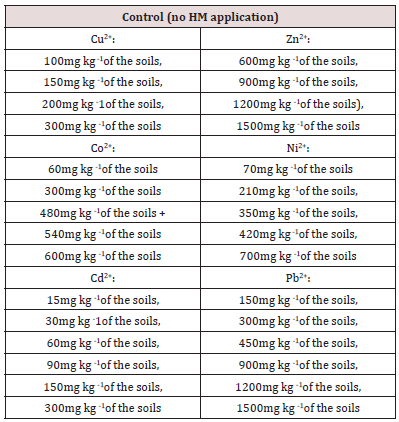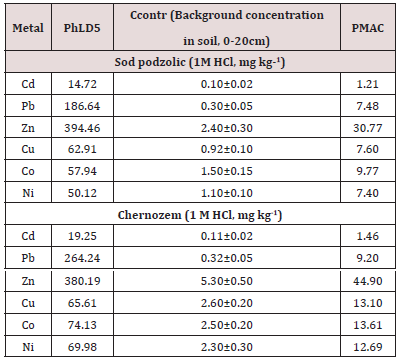In this paper, the influence of metals (Cd, Pb, Cu, Co, Ni, Zn) on
plants of spring barley (Hordeum vulgare L.) was investigated
in polluted sod podzolic sandy loam on layered glacial sands and
calcareous deep chernozem on loamy loess soils. We propose
to highlight the metals’ phytotoxicity with help of the Phyto Maximum
Allowable Concentration. The Phyto Maximum Allowable
Concentration is a permissible level of metals for plants in polluted
soil and represents the safe degree for plants in contaminated
ecosystem. The Phyto Maximum Allowable Concentration gives the
possibility to estimate and to forecast the danger of metals for
plants as a biological object that plays a very important role in the
life of ecosystem. This approach may be applied for another
metals phytotoxicity assessment for other plants.
Keywords:Metals; Plants; Phyto Maximum Allowable Concentration; Assessment, Pollution; Phytotoxicity
Introduction
Metals are significant environmental pollutants, and their
toxicity is a problem of increasing significance for ecological,
evolutionary, nutritional and environmental reasons Nagajyoti [1];
Bieby Voijant Tangahu [2]; Mamatha [3]; Metals, such as cadmium,
copper, lead, nickel, cobalt and mercury are major environmental
pollutants, particularly in areas with high anthropogenic pressure.
Metal accumulation in soils and plants is of concern in agricultural
production due to the adverse effects on food safety and
marketability, crop growth due to phytotoxicity, and environmental
health of soil organisms. The influence of plants and their metabolic
activities affects the geological and biological redistribution of heavy
metals through pollution of the air, water and soil Nagajyoti [1];
Gyuricza [4] Anthropogenic metals contamination of ecosystems
as a result of the application of industrial, transport, agrarian and
other technologies causes a damage of the functioning of plants
as an important component in ecosystem Bradl[5]; Alloway [6];
Kabata-Pendias [7] Often plants are the main accumulator of metals
in polluted ecosystem. In the same time, plants play an important
role in ecosystem as biomass producers and as biodiversity creators
Rombke [8]; Kabata-Pendias [7]; Sardar [9]. Usually phytotoxicity
is considered as a harmful influence of metal on plant growth and
development Kabata Pendias [7]; Nagajyoti [1]; Satpathy[10]; Gill
[11] . However, the setting of a safe level of toxicant for the plant is
also very important, because it can help to prevent and to control
the negative effects of metals in the ecosystem. Today a methodology
that would determine the safe concentration of metals directly for
plants in the soil is absent. After all, the existing standards for the
content of metals in environmental objects are sanitary-hygienic
and focused just on human health Lewis [12]; Smirnov [13]; Warne
[14]. Determination of the metals safe level in the soil for plants
can help to objectively assess state of the ecosystem and prevent
the metals dangerous influence on plant Ryzhenko [15]. The Phyto
Maximum Allowable Concentration (PMAC) was suggested as safe
level of metal in the soil for plants.
Materials and Methods
Spring barley (Hordeum vulgare L.) was selected as a model
plant. Spring barley (Hordeum vulgare L.) is one of the important
cereals crop in Ukraine. Mean standard deviations, variance, and
minimum, maximum, standard errors were calculated from at least
three replicates. The experimental results were interpreted using
standard statistical methods. The soils of experimental pots were:
sod podzolic sandy loam on layered glacial sands (sod podzolic) and calcareous deep chernozem on loamy loess (chernozem). Sod
podzolic soil has the following physic chemical characteristics:
pHsalt 5,5; organic matter by Turin 0,87%, CEC 6,3mg eqv/100g.
Chernozem soil has the following: pHsalt 6,2, organic matter by Turin
2,89%, CEC 27,1mg eqv/100g. Background concentration of metals
in soil (1 M HCl, mg kg-1) was: Cd - 0,1; Pb - 0.3; Cu = 0.92; Zn - 2.4;
Ni - 1.1; Co-1,5 (sod podzolic); Cd = 0.11; Pb - 0.32; Cu - 2.6; Zn - 5.3;
Ni - 2.3; Co - 2,5 (chernozem). Studied trace elements: Cd, Pb, Zn,
Cu, Co, Ni were applied separately in amount equal to the following
concentration in the soils (Table 1).
Table 1: Scheme of Experiment.

That amount corresponds with adopted in Ukraine Maximum
Allowed Concentration (MAC) in soil (Medvedev [16]. The following
metals salts: Pb(NO3)2, ZnSO
4. H
2O, CuSO
4.7H
2O, CdSO4, NiSO4·6H
2O,
CoSO4·7H
2O were used for the trace elements application. The
investigation was conducted in green house conditions. Plants
grew in plastic Mitcherlikh’s pots. Soil preparation, pots filling,
and trials were carried out in accordance with standard methodic
Dospekhov [17]; Medvedev [16]. The metals were added to soil
during soil preparation before filling the pots. Then, spring barley
germinated seeds were planted into the pots and, in the stage of 3
leaves, the recommended population was established. The studied
elements were extracted by 1 M HCl from the soils. The method of
HM determination was thin layer chromatography (TLC). Method
widely was used in our previous investigation and officially
recognized in Ukraine Kavetsky [18].
Results and Discussion
In this study, the algorithm of calculation of PMAC was proposed
similar to the existing approach of calculation of Maximum
Allowable Toxic Concentration (MATC) (equation 1) Rand [19].
In the toxicology practice, the scheme to substance toxicity
assessment using the LOEC and NOEC is quite effective and widely
used Smirnov [12]; Warne [13] Environment Canada. Guidance
document on statistical methods for Environmental Toxicity Tests
[20]; Globally Harmonized System of Classification and Labeling of
Chemicals (GHS), fourth revised version, [21]. These indicators are
used also for calculate the Maximum Allowable Toxic Concentration
(MATC) on behalf of assessing the toxicity of substances in the
aquatic environment. MATC is calculated by the formula Rand [19]:
MATC=√((NOEC)*(LOEC)) , (1)
where NOEC is No Observed Effect Concentration;
LOEC is Lowest Observed Effect Concentration.
We propose to determine the Phyto Maximum Allowable
Concentration by the formula:
PMAC=√(C_contr*〖PhLD〗_5 ) (2)
where Ccontr – background concentration (on the control variant
of experiment–without additional metal input);
The PhLD5 is phytotoxic dose 5% (PhLD5) caused reduction of
5% of initial weight (height, length of root etc.).
In our opinion, 5% reduction of initial weight (height, length of
root etc.) is the minimal effect, which is similar to the LOEC shows
the preliminary changes in the productivity of the plant population.
Moreover, the level of significance of deviations, which are
considered sufficient for ecological and biological research at the
level of 5% (p <0.05) was chosen. The algorithm of obtaining the
PhLD5 was represented in previous papers Ryzhenko [22]. Table 2
shows the values of PhLD5 and PMAC for all investigated metals,
as well as the background concentration in soil (0-20 centimeters).
PMAC was obtained with the help of equation 2. The PMAC for Cd in
sod podzolic soil was calculated in this way:
Table 2: PhLD5, PMAC, and background concentration in soil
(0-20 centimeters,1N HCl, mg kg-1).

〖PMAC〗_Cd=√(0.1*14.72) =1.21 mg kg-1 (3)
The PMAC for Ni, Pb, Cu, Co, Zn in two soils were calculated
similarly.
The lowest value of the PMAC had Cd, the highest value of the
PMAC had Zn in two studied soils. The chornozem soil ad higher
values of the PMAC than Sod podzolic soil. It could be explained
by higher content of organic matter, granulometric composition of
soil and other properties of chornozem soil. According to the value
of PMAC, the metals can be ranked in the following descending
order: Zn>Сo>Cu>Ni>Pb>Cd. The PMAC could be used as an
environmental standard that regulate the safe level of pollutants in
the soil for plant [23-25].
Conclusion
As a result of this investigation, it was proposed to use the Phyto
Maximum Allowable Concentration as a permissible level for plants
in soil in the polluted ecosystem. The algorithm of calculation of
Phyto Maximum Allowable Concentration based on the approach of
the existing calculation of Maximum Allowable Toxic Concentration
(MATC). The Phyto Maximum Allowable Concentrations were
obtained for Hordeum vulgare L. for all researched metals in two
soils (mg kg-1;1 N HCl): Cd–1.21; Cu – 7.60; Co–9.77; Zn – 30.77;
Ni – 7.40; Pb – 7.48 (sod podzolic sandy loam on layered glacial
sands), and Cd – 1.46; Cu – 13.10; Co–13.61; Zn– 44.90; Ni – 12.69;
Pb –9,20 calcareous deep chernozem on loamy loess). The Phyto
Maximum Allowable Concentration gives the possibility to set the
permissible level of metal in soil for plant as a biological organism,
but not from the point of view of hygienic regulation. The using
of concept of Phyto Maximum Allowable Concentration may be
suitable for receiving a permissible level of metals in different soils
for other plants in polluted ecosystems. Phyto Maximum Allowable
Concentration gives the possibility to estimate the danger of
metals directly for plants as a biological object that playing a very
important role in the life of ecosystem.
For more
Lupine Publishers Open Access Journals Please visit our website:
https://lupinepublishersgroup.com/For more
Journal of chemistry sciences Please Click Here:
https://lupinepublishers.com/chemistry-journal/
To Know More About
Open Access Publishers Please Click on
Lupine Publishers



No comments:
Post a Comment
Note: only a member of this blog may post a comment.